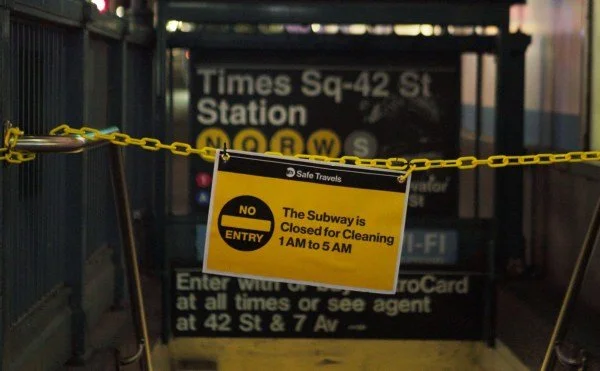END OF THE LINE shows how many challenges face New York's MTA
Directed by Emmett Adler
Unrated
Run time: 65 minutes
Available digitally
by Megan Bailey, Staff Writer
Dedicated to the MTA workers lost to COVID in 2020, End of the Line chronicles the state of the New York City subway from 2016 to 2021 and the many ongoing political conflicts that stirred up around its maintenance and updating. Emmett Adler’s documentary begins with setting the scene in 2016: though the subway system is vitally important to keeping New York City running, stations are falling apart, trains are always running late, and then-mayor Bill De Blasio disagrees with then-governor Andrew Cuomo on who was responsible for maintaining the MTA subway system. Finally, Cuomo declares a state of emergency and announces Andy Byford to be the new president of New York City Transit. Several talking heads comment on how they had high hopes for Byford, as he was highly respected with great experience working on public transportation systems. So you know what that means; it’s time for some daunting music and a sense of foreboding.
Let me stop here and mention that I moved to New York last July. While I would never call myself a New Yorker, I ride the subway often enough that I understood a lot of what was talked about here. The documentary shows what happens to a neighborhood where a subway station was closed, and a bodega owner comments that their business has gone down 60%, devastating them and the businesses around them. Without commuters, areas will absolutely lose revenue (and community). On the upside, seeing the gorgeous shots of the city and the elevated trains framed by the skyline was a reminder that even when things are falling apart, there is beauty here.
There are a few throughlines (heh) in this documentary. In addition to following Cuomo’s handling of the MTA, we see Antonio Reynoso, a New York City Councilman for the 34th District as he helps his constituents first with MTA issues and then with COVID supplies. Once Andy Byford is introduced, we also see him reflect on his time in the city (remember that sense of foreboding?), and of course, lots of footage of commuters on the subway and the city itself. In addition, the journalists who have covered the MTA comment throughout. As the documentary goes on, we find out exactly what happens with Byford, who was shoved out of his position after only two years, with very little to show for his time there. The footage of his last day as he rides the subway and thanks MTA workers for their dedication was quite emotional.
For all that he was hyped in the beginning, we see that his work was cut back before he could really improve much of anything. What this documentary boils down to is that the subway system has always been slow to update or repair, susceptible to political maneuvering, and ultimately, a life-line that is desperately in need of maintenance in order to keep everything running smoothly for the New York City population. And this whole doc serves as just one example of how failing infrastructure impacts everyone. If COVID taught us anything, it’s that our current systems aren’t equipped to protect common people (and indeed, those in power don’t always want to improve, or even maintain, the systems that are in place).
To that end, I think it’s a very well-made documentary. The storylines come together by the end, and the unfortunate reality of COVID settles in right at the time when I’d gotten engrossed enough to forget that it was coming. I found the talking heads helpful as they detailed the many problems, who was actually attempting to improve the system, and who was just doing some PR posturing. At times, this doc feels like a political who-dun-it, centering on what happens when Cuomo decides to change the MTA’s improvement plan without saying a word to any of them. Obviously, Adler and the team had no idea that COVID was coming when they started this documentary in 2016, and I found Reynoso’s commentary on how the pandemic has affected Black and brown people more, not because COVID discriminates, but because our society does, especially poignant.
While it’s stated that the doc covers 2016-2021, it seems to mostly stop around late 2020, depicting how COVID has affected the MTA. I think a bit more expansion on that could have helped. When one subject mentions that they weren’t expecting the pandemic to last six months, it felt like some cruel irony. Six months? Try more than two years. I also think there could have been some mention of Cuomo’s later scandals, including his handling of COVID, which he was first commended for, until more and more issues came to light. The doc does show how it affected MTA workers and the subway system, stopping its 24/7 service for the first time in history because of the pandemic. For all the hand-wringing done about who’s responsible for the MTA, I don’t feel like we came away with an answer. The ending text shows that there’s much more work to be done, but not who needs to do it. However, while it may not be the sexiest movie you’ll see this year, End of the Line is really informative and packs a lot into its hour-long runtime.

